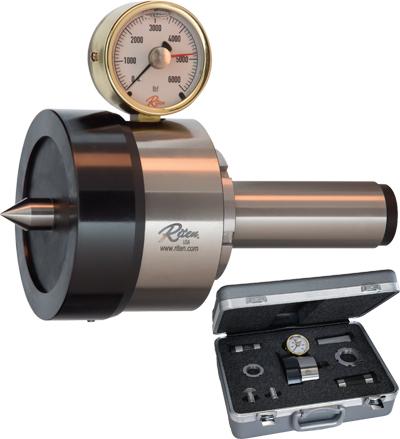
For many precision jobs using a face driver, it is critically important to know the exact force applied to the workpiece by the hydraulic tailstock. Riten Industries Inc. offers a tailstock force gauge to allow users to eliminate any guesswork, especially on older machines.
The force gauge, in conjunction with the tailstock's hydraulic cylinder pressure reading, accurately calibrates the lathe or grinder to reportedly deliver the precise load for faster setup and repeatable, scrap-free production.
The liquid-filled, anti-vibration analog gauge displays force from 200 to 6,000 lbs., and features dual indicators: the black needle shows actual force at any point in the test procedure, while the red needle becomes permanently set at the highest reading recorded during the period. Gauge accuracy is 1.5 percent full scale.
The gauge can be ordered as a complete kit, or by specifying individual components. The kit includes the gauge assembly, 4 MT, 5 MT and 1 ½ SS mounting shanks, a male and a bull nose point to accommodate different center hole diameters, and a lockable padded carrying case. Additional bull nose points are available, as well as specialized points and customized shanks. Riten can supply any configuration to fit the workpiece.
Contact Details
Related Glossary Terms
- lathe
lathe
Turning machine capable of sawing, milling, grinding, gear-cutting, drilling, reaming, boring, threading, facing, chamfering, grooving, knurling, spinning, parting, necking, taper-cutting, and cam- and eccentric-cutting, as well as step- and straight-turning. Comes in a variety of forms, ranging from manual to semiautomatic to fully automatic, with major types being engine lathes, turning and contouring lathes, turret lathes and numerical-control lathes. The engine lathe consists of a headstock and spindle, tailstock, bed, carriage (complete with apron) and cross slides. Features include gear- (speed) and feed-selector levers, toolpost, compound rest, lead screw and reversing lead screw, threading dial and rapid-traverse lever. Special lathe types include through-the-spindle, camshaft and crankshaft, brake drum and rotor, spinning and gun-barrel machines. Toolroom and bench lathes are used for precision work; the former for tool-and-die work and similar tasks, the latter for small workpieces (instruments, watches), normally without a power feed. Models are typically designated according to their “swing,” or the largest-diameter workpiece that can be rotated; bed length, or the distance between centers; and horsepower generated. See turning machine.

